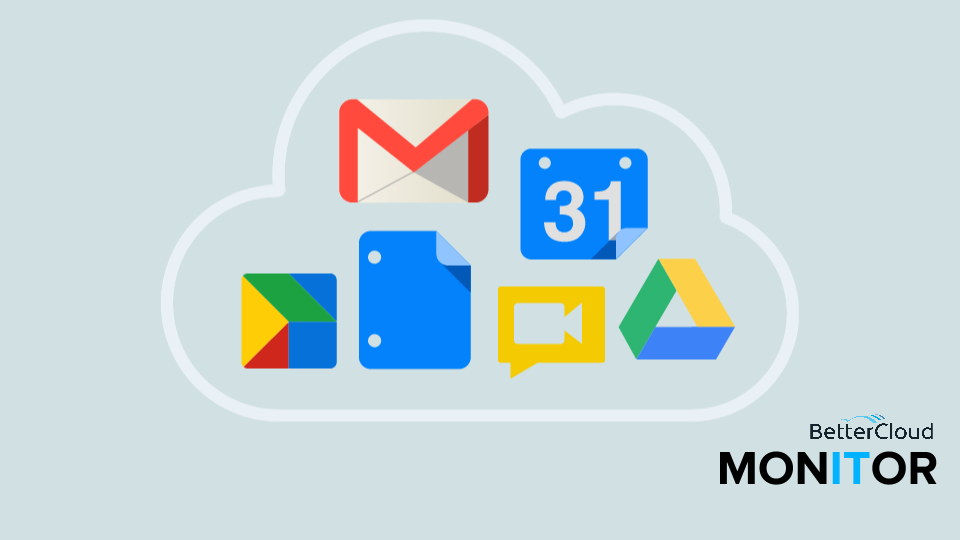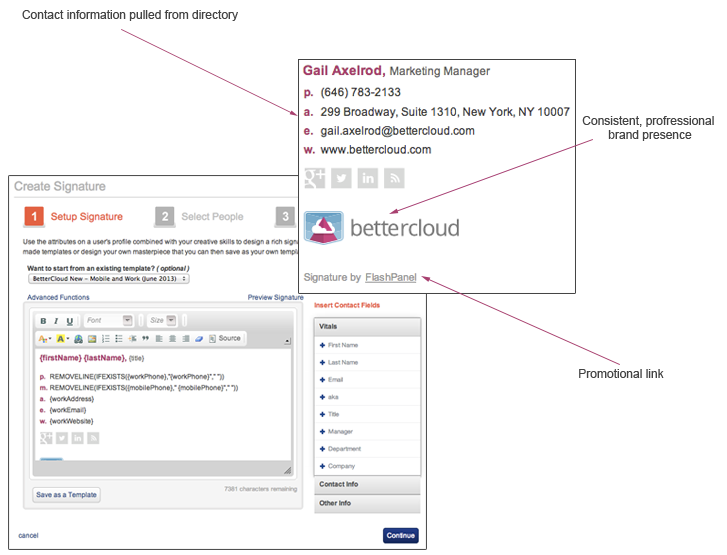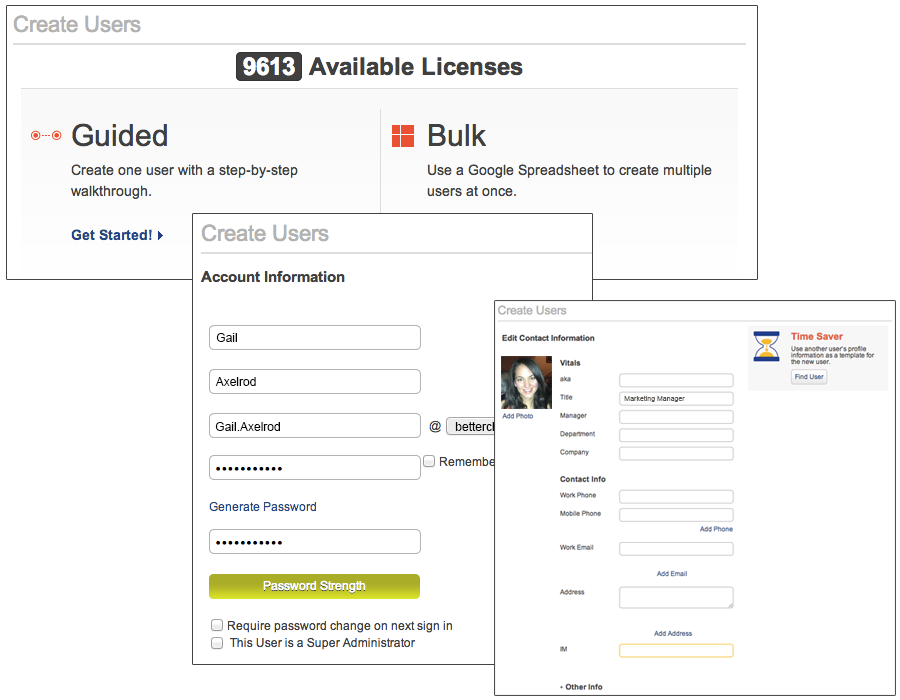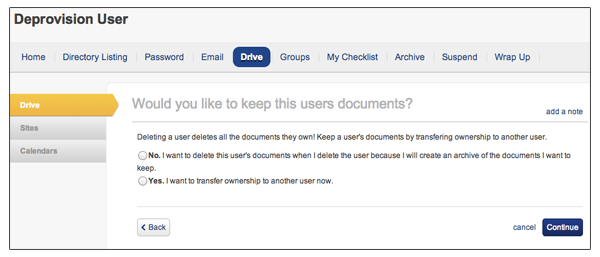Optimizing for Long Term Google Apps Adoption
June 20, 2013
14 minute read

During my time in the Google Apps space – about 4 years – I’ve experienced hundreds of migrations, interacted with thousands of Google Apps administrators and have seen how millions of businesses benefit from the platform year after year. However, all too often, the move to Google Apps is seen as everything that comes before and up until the migration. But there’s so much more to be done once you make the move to the cloud. So here, in my own words is a comprehensive guide to rolling out Google Apps post migration. Please leave your own best practices in the comments section below.
While most readers have already gone Google, it’s important to keep in mind that once you’ve completed the migration – in other words “flipped the switch” – the work is not over. Not only does Google introduce hundreds of updates every year, but the makeup of your organization changes over time as employees come and go.
While the cloud definitely has its benefits, operating on a new platform changes the dynamics within your organization. Features that make the cloud so great, like the ability to access your data from anywhere on any device, can also turn into potential security threats when not properly managed. And frequent software updates mean there are many more moving parts to keep in mind when compared to static, on-premise collaboration or messaging software.
Whether Google is replacing an outdated Exchange server, or your business has been operating on the platform since its founding, keep in mind that Google Apps – email, chat, calendar, collaboration – lies at the core of everything your employees do. So as important as your CRM, Marketing Automation or Accounting systems are, these pieces of software really only touch select departments.
Your entire user base on the other hand lives in their inbox, relies on their calendar and requires collaboration tools like Drive just to accomplish the basics of everyday business.
If you’re new to Google, your company likely spent significant time and resources on Exchange or one of its competitors. Think of the certifications, hours of user training and possible server upgrades you had to go through. While these tasks were both costly and time consuming, you (and your company’s management) felt they were worthwhile.
Now that you’re on the Google platform, you need to invest just as much time. After all, the more you buy into the vision, the more you’ll get out of the platform in the end. You’re not likely to move off Google Apps – our reseller partners note that customer retention is nearly 100% – or the cloud for that matter, anytime in the near future, or ever (who knows what, if anything, will come after the cloud), so it’s well worth it for you, your IT team and end users to get used to the platform and find the best ways to optimize your use and management of Google Apps.
But, how do you do that?
Click the numbers in the graph to navigate the post.
I recommend that larger organizations work through the following phases with the help of an experienced Google Apps reseller. Resellers have the benefit of helping thousands of companies make the move to Google Apps and roll out the entire suite. Their expertise will help to ensure you avoid common pitfalls to truly get the most out of the platform.
Phase 1 – Setting Yourself up for Long-Term Success
I believe the ongoing management and optimization of Google Apps can be broken down into three phases. This first phase involves setting the foundation for long-term success, ie. making sure you’ve properly structured organizational units (OUs), put in place various security measures and standardized the operating experience for your entire user base.
1. Organizational Units
Though often overlooked, organizational units are the foundation of Google Apps. Properly creating OUs gives you the ability to manage your users and organization on a level of such granularity that’s simply not possible otherwise. While putting in the time to properly format OUs can be painful, the return will be well worth it down the road.
How you structure OUs will vary from organization to organization, but most organizations typically structure OUs based on three “parent” organizations: department, location or level of access to services.
-
- Department: If you choose to set up OUs based on departments within the organization, it’s likely because you need to grant different types of access or services to different users. For instance, if you do not want your interns using Google Talk / Hangouts or Google+, you can create a separate “Intern OU” to prohibit the use of those services while still enabling them for others in the organization.
-
- Location: Obviously, if you only have one geographic location, or your locations are very similar (like New York and Atlanta), you probably won’t set up OUs based on location. But, if you have locations in France, Mexico, Hong Kong and the US, setting up OUs by location is a good idea since there are different time zones, privacy laws and languages involved.
- Level of Access to Services: One of our favorite Google Apps admins, Justin Gale, structures his organization’s OUs by the level of access to services different users are granted. To learn more about structuring OUs in this manner, check out Justin’s blog here.
Throughout this post, you’ll see just how important OUs are as they’re mentioned in nearly every following step and phase.
2. Access Roles
Now that you’ve properly structured and added users to OUs, you’ll want to create Access Roles for certain users. Access Roles give you, the Super Administrator, the ability to grant limited permissions without having to give full rights to another member of your organization. Too many organizations start out by granting a handful of people super admin access, which becomes an inconvenience to take away down the road. Invest the time upfront to define access and responsibilities properly. Doing so will not only protect your domain, but you’ll be able to delegate certain tasks more efficiently.
As for assigning roles, your CEO will likely want certain access, as will your HR director probably in order to manage onboarding and offboarding employees, and your Marketing Director might want access to manage employee signatures.
When you’re creating Access Roles, keep in mind that you should only grant permissions that are absolutely vital. Reexamine how many super administrators you actually have on your domain and remove unnecessary permissions.
3. Password Policies
Just as access roles can shore up your organization’s security by only granting absolutely vital rights, password policies will add another layer of security to your organization.
Although forcing password resets for your users on a regular basis is a fairly simple concept, it’s seldom done because of the manual requirements. However, using a third-party tool, you can actually automate password resets on a recurring basis for certain users, or by OU. While we usually suggest resetting passwords every six months, this will vary depending on the organization.
4. Email Signature Standardization
While password policies are a definite no brainer, creating a standardized email signature is something that goes overlooked all the time. Often times, users from the same organization will have completely different signatures, or they won’t have one at all. Think about how many emails go out from your organization every day and think about all the people who see your company’s email signature or lack thereof. If your signature is inconsistent or blank, you’re not putting your best foot forward, but if you have a consistent signature, you’re able to take advantage of the marketing opportunities that go along with every email you send.
While you, the IT admin, or your Marketing Director can create an email signature, copy and paste that signature into an email, email it to your employees and then ask them to set it up in their individual Gmail settings, 50% of users won’t do so and those that do may tweak items like the font or colors – so again, good try, but you’re still left with varying email signatures.
To create truly standardized email signatures and push them out on a regular basis to override user changes, you’ll need the help of a third party tool. And if you’ve set up OUs by department, you can push out different signatures for different departments.
While standardizing email signatures is the first step in creating a unified brand presence in company email, you can get so much more out of signatures – think about including tracked links to company promotions or links to social media pages.
 FlashPanel Email Signature Standardization
FlashPanel Email Signature Standardization
If your organization requires the addition of a footer for legal compliance, you can set this up on an OU by OU basis in the Google Apps Admin Console. To create and apply the footer, go to Settings > Gmail in the Admin Console and then scroll to Compliance where you can add a custom footer. While the footer is applied after you hit Save, it will only be appended to emails sent outside of the domain.
5. End User Optimization
While so far Phase 1 has covered a number of items geared towards super administrators, there are also important steps your end users can take in this phase to help with their adoption of Google Apps.
From adding relevant contacts to Google Talk / Hangouts and Calendar, using only the Chrome browser and setting up email labels and filters, turning on relevant Gmail labs and determining Inbox type, to installing Google Apps related iOS and Android applications, there’s so much your end users can do to ensure their success and quick transition to the platform.
Phase 2 – Ongoing Management and Optimization
Following the initial setup in Phase 1, you may experience “deployment fatigue.” Perhaps you’re already in the final phase of a Salesforce or Zendesk rollout, or you’ve been too busy with Google Apps to manage other ongoing duties. Either way, Phase 2 gives Google Apps a chance to burn in and allows you to see to other ongoing projects outside of Apps.
While Phase 2 is relatively low maintenance, there are still important tasks to manage.
1. User and Group Management
During Phase 1, you likely added several new users, but have you customized the appropriate settings? If you provisioned employees using Active Directory or a similar tool, you were likely unable to apply an email signature, set password policies or add the users to Google Groups.
To make sure users have been provisioned following the guidelines set forth in Phase 1, you can use a bulk directory update tool, like the one found in FlashPanel. Using an exported spreadsheet of your directory, you can easily make changes and then upload that spreadsheet back into FlashPanel. Any updates will be automatically pushed out.
When you do go to add new users following Phase 1, you can significantly streamline the process by using a tool like the Provisioning Workflow found in FlashPanel.
While the process of adding new users to your domain is not challenging, it does take time to ensure that each user is provisioned in the correct way for his or her function and / or location. Provisioning a user correctly when they first join your company will save you time later on – you won’t be going back and forth adding them to different groups or provisioning the right services.
FlashPanel’s workflow walks you through each step of the provisioning process to ensure you’ve covered all the appropriate areas detailed in Phase 1.
 FlashPanel Provisioning Workflow
FlashPanel Provisioning Workflow
Deprovisioning users properly is just as important as provisioning them properly. Consider all of the information a user has access to on your domain – Google Drive documents, your intranet, third-party services using Single Sign On and perhaps even certain administrative rights.
But when an employee leaves, you can’t just delete their account immediately as doing so will delete all of their Google Drive items as well. It’s important to walk through certain steps before finally suspending and deleting a user’s account.
To ensure a smooth transition and eliminate potential data loss, it’s important to follow these 9 steps when deprovisioning a user.
-
-
- Hide the user’s listing in the directory
- Reset the user’s password
- Delegate their email
- Reassign ownership of Google Drive items
- Remove the user from Groups
- Create a custom checklist and retrieve / complete items on your list
- Archive the user’s email (may require a 3rd-party solution)
- Suspend the user
- Wrap up the deprovisioning process and delete the user
-
If you properly deprovision a user’s account, data loss upon their account deletion should not be a concern, plus deleting versus suspending the user will free up the license. And lastly, with everything properly reassigned, the departing employee’s manager or an oncoming employee can easily take over Drive documents and neglected emails.
FlashPanel’s deprovisioning workflow walks you through each of the nine steps seamlessly.
 FlashPanel Deprovisioning Workflow
FlashPanel Deprovisioning Workflow
3. Support
Now that we’ve covered the basics of onboarding and deprovisioning employees, let’s talk about ongoing support and education, for both you and your end users.
-
- User Education: Some employees may be slow or even reluctant to embrace your organization’s move to Google Apps. Make sure you provide them with the support tools they need to ensure their success, and if not at first, eventual appreciation for the platform. Users need to understand how and why these changes will help them be even better at their jobs.
Free help sites like googlegooru.com provide short how-to videos on basic tasks like sending an email all the way to advanced tips on collaborating in Google Drive. And paid services provided from companies like Synergyse (one of the coolest training products I’ve seen) will actually walk your users through various aspects of the Google Apps suite.
- User Education: Some employees may be slow or even reluctant to embrace your organization’s move to Google Apps. Make sure you provide them with the support tools they need to ensure their success, and if not at first, eventual appreciation for the platform. Users need to understand how and why these changes will help them be even better at their jobs.
-
- Technical Support: While self help tools provide great education, your end users sometimes simply need more “hands on” help. Using remote tools like Chrome Remote Desktop, you can actually remotely access a user’s computer (pending the proper permissions have been granted), to view and hopefully fix the issue.
On the other hand, third-party tools that allow you to update user information or Gmail settings on a user’s behalf or delegate an inbox on the backend, like FlashPanel, override the need to remote into a user’s device and allow you to quickly and efficiently manage a user’s account.
- Technical Support: While self help tools provide great education, your end users sometimes simply need more “hands on” help. Using remote tools like Chrome Remote Desktop, you can actually remotely access a user’s computer (pending the proper permissions have been granted), to view and hopefully fix the issue.
- Admin Education: While supporting end users is crucial, it’s also important that you as an IT administrator stay up to date with the latest Google Apps updates and best practices. Attending various Google user groups, subscribing to updates from the Google Enterprise blog and participating in Google Apps related Google+ communities and user groups will keep you up to speed.
4. Ongoing Monitoring
Now, your users are all set up for success, right? You can’t be sure how users are adopting Google Apps without monitoring and reporting on their adoption. Using either the Google Apps Admin Console, which provides a snapshot overview, or a third-party tool for more granularity, you can evaluate how users are adopting Google Apps.
Are you users running out of storage? It might be because they’re still using MS Word and uploading those files to Drive. Or are they creating hundreds of Drive documents when you’ve yet to officially roll out the system? This might signify that your users are ready to take on more of the Google Apps suite.
Reporting tools will also allow you to examine the number of suspended users on your domain, the number of available licenses, which users are forwarding email, public Drive exposures and much more.
Phase 3 – Mini-projects and Feature Rollouts
Even if you’ve given your users access to every feature in Google Apps from day one post migration, they can only get so far without proper change management and leadership from the top. And if your users are skilled in Google Apps’ existing features, there are constant updates and feature rollouts to be aware of.
There are a number of products and services that you might consider rolling out in Phase 3, but here’s a sampling ordered to represent the most typical rollouts:
- Collaboration: Google Drive and Google Sites
- Social: Google+ (and Hangouts)
- Google Apps Marketplace Applications
Let’s talk about the different steps you should take to ensure a successful rollout.
1. Determine the requirements
This one may be obvious, but why is your organization interested in deploying this new technology? There are a number of reasons you might consider deploying any of the following products, and each requires completely different strategies and tactics.
These requirements may come from your executive team, end users, or IT exclusively. But it’s important to clearly define the requirements and goals of the project.
-
- Google Drive: Do you want to replace your file server, improve collaboration among users or move away from MS Office products?
-
- Google Sites: Are you looking to build an intranet? Do you conduct long term external projects and want team members to collaborate with clients on project sites?
-
- Google+: Do you want to move away from products like Yammer and employ Google+ as an internal social network? Or do you want to start embracing Hangouts as a replacement for more traditional conferencing services?
- Google Apps Marketplace Applications: Do certain OUs need add ons like a CRM that integrates deeply with Google Apps or are you looking to track hours worked by contract employees?
2. Phased rollout
No matter what advanced product you’re deploying, we recommend rolling out the service in phases as different users will have different needs and experience levels. Some users may be familiar with the product in question, while others will see the new product as a nuisance, or worse, an impediment to how they’re used to operating. A phased rollout helps you build consensus and learn the common pain points associated with each new feature before moving onto the next phase.
Below, we’ve applied the basic steps of a feature rollout to Google Drive, the most commonly deployed feature following the move to Google Apps.
Keep in mind that the time taken between each step will differ depending on the size of your organization and the makeup of your users – it could be weeks or it could be months, but what matters the most is that you go at your own pace and listen carefully to your users.
-
- Test the feature in your IT department: Recreate important documents in Google Drive and add them to shared folders. Make sure IT employees are accessing the information they need exclusively through Google Drive.
If your goal is to really get rid of Microsoft Office licenses then while you’re in this testing phase you may realize that you need a Visio replacement or a project management tool that integrates with Drive. In the Google Apps Marketplace you’ll find apps like Lucidchart and Smartsheet that can help your organization make a full transition.
- Test the feature in your IT department: Recreate important documents in Google Drive and add them to shared folders. Make sure IT employees are accessing the information they need exclusively through Google Drive.
-
- Pinpoint early adopters: You can either find early adopters to test out Drive through a survey (sent through Google Forms of course), or, if you’ve left Drive on before the official rollout, you can use a monitoring tool to view any passive Drive use. Employees with the most Drive documents are good candidates for your early adopter group.
-
- Establish an OU for these early adopters
-
- After users have tested the feature, survey the group (again, through Google Forms) to find out what they do and do not like
-
- Designate a group of these early adopters as Google Guides who can help with your general rollout
- Roll out the new feature to your entire user base: Set up templates in Drive, share out important company information, like the Employee Handbook, as a Google Doc to ensure employees have to access Drive in order to view it and monitor adoption using advance reporting tools.
Steps 1 through 5 should be fairly easy as you’re dealing with users who are already familiar with Google Apps, but step 6 is going to take more effort. Remember that if you can get members of your management team involved as early adopters, you’re more likely to win users over during the general rollout. You’ll need to invest considerably in change management. The biggest mistake enterprises make when pushing Google Apps is not spending the time or effort on user training to explain how and why the changes will benefit users in the end.
3. Celebrate Your Accomplishments
Once you’ve successfully rolled out a new feature, make sure you celebrate that accomplishment. I’ve actually seen companies buy thousands of dollars of gear from the Google Store to celebrate every major launch. And I’ve seen other companies give awards to the most Google enabled person in the organization.
While adopting new aspects of the Google Apps suite may take time, doing so shouldn’t be painful. And the more your users see that, the easier it will be to roll out more and more of the suite.
Final Thoughts
Google Apps can be a truly transformative technology when it is deployed properly and embraced by end users and your organization’s leadership. While the steps for rolling out Google Apps are laid out before you, its important to note that the suite is not like a traditional software system – it’s extremely dynamic, meaning features will be deprecated, more functionality will be introduced and the UI will change. But, now that you’re armed with this process, you have the skills to adjust to any changes that come your way.
Put in the time now to properly set up Google Apps so that down the road you can make the system work for you. Once you’re comfortable working with Apps, look for complementary software that heavily integrates with the platform to provide the most benefit to your organization. Realize “going Google” is not a onetime project, but rather an ongoing investment and foundational piece in your company’s IT infrastructure that’s not likely to be replaced for decades.










